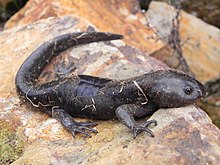Ambystoma rivulare is a species of mole salamander in the family Ambystomatidae. Typically gains a lot of population distribution in the Trans-Mexican Volcanic Belt around central Mexico City. Found in various small or medium-sized ponds and lakes that have large and wide range of food options, all within a distance of at least 2 km.[2] It is endemic to Mexico. Its natural habitats are subtropical or tropical moist montane forests and rivers. It is threatened by habitat loss. The larvae, who continue to prey on the same organisms as they grow, prey mainly on ostracods as well as some gastropods and assorted other prey with limited diversity.[3] Ambystoma rivulare continue to live in the river they hatch in post-metamorphosis.[4] Research on the Michoacan Stream Salamander (A. Rivulare) has important implications for the conservation and persistence of these salamanders. The lack of variety in the A. rivulare diet puts them in a precarious situation should environmental factors endanger the ostracod population in their habitat. Further, a study done at the University of Sao Paulo on the diet of A. rivulare shows no relationship between size and the salamander's diet, suggesting a lack of larger prey for the bigger salamanders to eat.[5]
| Ambystoma rivulare | |
|---|---|

| |
| Scientific classification | |
| Domain: | Eukaryota |
| Kingdom: | Animalia |
| Phylum: | Chordata |
| Class: | Amphibia |
| Order: | Urodela |
| Family: | Ambystomatidae |
| Genus: | Ambystoma |
| Species: | A. rivulare
|
| Binomial name | |
| Ambystoma rivulare Taylor, 1940
| |
References
edit- ^ IUCN SSC Amphibian Specialist Group (2020). "Ambystoma rivulare". IUCN Red List of Threatened Species. 2020: e.T59067A53974395. doi:10.2305/IUCN.UK.2020-2.RLTS.T59067A53974395.en. Retrieved 17 November 2021.
- ^ Heredia-Bobadilla, Rosa-Laura; Monroy-Vilchis, Octavio; Zarco-González, Martha M.; Martínez-Gómez, Daniel; Mendoza-Martínez, Germán David; Sunny, Armando (December 2016). "Genetic structure and diversity in an isolated population of an endemic mole salamander (Ambystoma rivulare Taylor, 1940) of central Mexico". Genetica. 144 (6): 689–698. doi:10.1007/s10709-016-9935-9. hdl:20.500.11799/71079. ISSN 0016-6707. PMID 27796527. S2CID 42803761.
- ^ Lemos-Espinal, Julio A. (2015). "Diet of larval Ambystoma rivulare (Caudata: Ambystomatidae), a threatened salamander from the Volcán Nevado de Toluca, Mexico". Phyllomedusa: Journal of Herpetology. 14 (1): 33–41. doi:10.11606/issn.2316-9079.v14i1p33-41.
- ^ Heredia-Bobadilla, Rosa-Laura (28 October 2016). "Genetic structure and diversity in an isolated population of an endemic mole salamander (Ambystoma rivulare Taylor, 1940) of central Mexico". Genetica. 144 (6): 689–698. doi:10.1007/s10709-016-9935-9. hdl:20.500.11799/71079. PMID 27796527. S2CID 42803761.
- ^ Lemos-Espinal, Julio A. Diet of larval Ambystoma rivulare (Caudata: Ambystomatidae), a threatened salamander from the Volcán Nevado de Toluca, Mexico. (2015). Phyllomedusa: Journal of Herpetology, 14(1), 33-41. https://doi.org/10.11606/issn.2316-9079.v14i1p33-41
